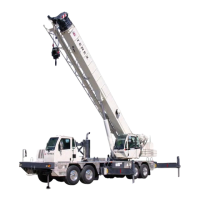Mobile Crane Load Test Inspection
General
As a worldwide crane manufacturer, Terex Cranes does not recommend carrying out a
regular overload test on mobile cranes.
An overload test after every change of location or crane reconfiguration is not a reliable and
safe inspection method and can cause premature material fatigue.
In some countries, national laws require overload tests e.g. in accordance with information
from the crane manufacturer.
Every mobile crane is subjected to a load test by the manufacturer within a final
acceptance procedure before delivery. These tests are carried out with test loads in
different configurations in accordance with the scenarios with the lowest safety reserves in
relation to mechanical strength and stability of the crane. This includes an overload test
with defined conditions and standards which can be applied accordingly.
Further acceptance tests with overloads during the cranes working life must only be carried
out after modifications or repairs of load-bearing components or within an extensive
overhaul. In some countries, national regulations may require tests with overload and/or
overload tests before carrying out hoist work after any change to the crane configuration.
The calculation of the load-bearing structure of mobile cranes satisfies all applicable
international standards (EN, ISO, FEM, etc.) and does not provide for continuous operation.
The cranes therefore have a service life which is defined by the permitted number of
working cycles. Any overloading of the crane can have a negative effect and leads to a
reduction in the cranes service life. This can become a critical problem if the crane is tested
with overload before every hoist operation (e.g. when building a wind farm with 80 to 100
wind turbines at one location within a few weeks...).
Terex Cranes strictly prohibits operator to raise an overload with any crane. Safety
equipment such as load limit devices prevent overloads being raised; the corresponding
bridging / override switch is only provided for emergency situations or when the load limiter
fails (as determined in the operating instructions).
Load and Overload Test
As the manufacturer, Terex Cranes does not recommend using the bridging / override
switch regularly for overload tests and generally advises against regular overload tests -
even including tests during which the test load is attached via external equipment without
activating the bridging / override switch.
Decreased service life due to regular overload tests.
As a manufacturer, Terex Cranes aims to avoid overload tests, as such tests
decrease the service life of the cranes.
The following aspects must also be taken into consideration from the viewpoint of the user/
operator:
153P/N 12261-683 REVISED: January 2015

